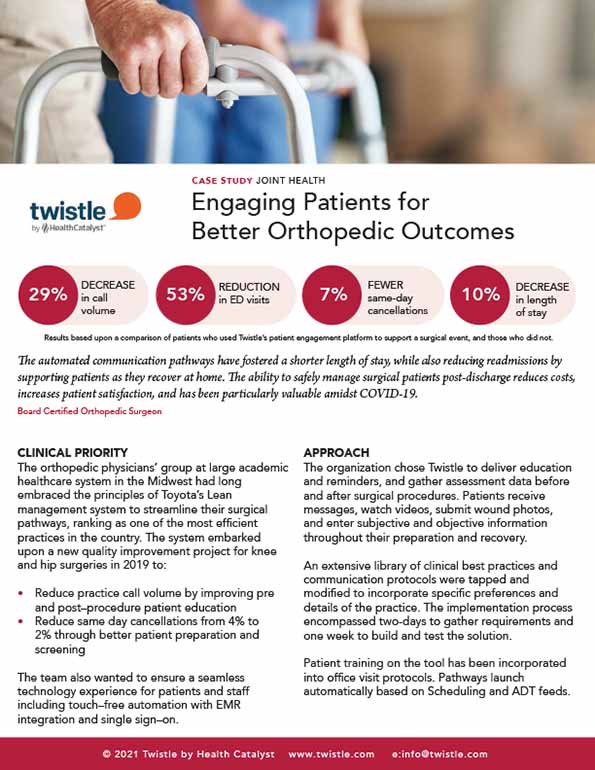The orthopedic physicians’ group at this large academic healthcare system in the Midwest had long embraced the principles of Toyota’s Lean management system to streamline their surgical pathways, ranking as one of the most efficient practices in the country. Read how the organization deployed Twistle to deliver education and reminders to patients undergoing orthopedic surgical procedures.
The orthopedic physicians’ group at this large academic healthcare system in the Midwest had long embraced the principles of Toyota’s Lean management system to streamline their surgical pathways, ranking as one of the most efficient practices in the country. The system embarked upon a new quality improvement project for knee and hip surgeries in 2019 to:
The team also wanted to ensure a seamless technology experience for patients and staff including touch–free automation with EMR integration and single sign–on.
The organization chose Twistle to deliver education and reminders, and gather assessment data before and after surgical procedures. Patients receive messages, watch videos, submit wound photos, and enter subjective and objective information throughout their preparation and recovery.
An extensive library of clinical best practices and communication protocols were tapped and modified to incorporate specific preferences and details of the practice. The implementation process encompassed two-days to gather requirements and one week to build and test the solution.
Patient training on the tool has been incorporated into office visit protocols. Pathways launch automatically based on scheduling and ADT feeds.
"The automated communication pathways have fostered a shorter length of stay, while also reducing readmissions by supporting patients as they recover at home. The ability to safely manage surgical patients post-discharge reduces costs, increases patient satisfaction, and has been particularly valuable amidst COVID-19."
- Board Certified Orthopedic Surgeon
The team compared the patient population undergoing surgical knee or hip replacement from January through August 2019–the control group, with those treated from September 2019 through February 2020–the experimental group.
"Twistle has improved our office staff workflow by significantly reducing phone call volume. The automated delivery of routine education and reminders has allowed our practice to quickly identify and manage patient care issues."
- Clinical Nurse Coordinator
This large academic health system improved the orthopedic patient experience to increase compliance with surgical preparation, reduce complications, and generate additional revenue. The program improves quality of care by delivering clinical pathway–based education, reminders, and assessment data collection forms that keep patients on track while facilitating early intervention when they deviate from the plan of care. High patient adoption rates are driven by the program’s meaningful and relevant content and a sense of connectedness with the care team.


